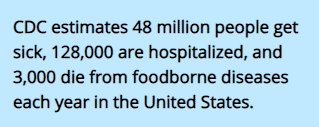Was FSMA a failure?
January 2021 was an important month in the United States.
With all the chaotic events that occurred in Washington D. C., it might have been easy to miss the fact that January 2021 was the 10 year anniversary of President Obama signing FMSA into law.
I have written several blogs in the last number of years asking questions ranging from whether Donald Trump’s administration might have an impact on FSMA, to how FSMA itself might impact the GFSI schemes.
When FSMA was signed into law, its intention was to provide the FDA the necessary teeth it required to be more effective, however, after a decade of being in existence a fair question to ask now seems to be “is FSMA all that it was cracked up to be?”
Surely, all of the hoops the industry jumped through for FSMA weren’t for nothing?
Surely, all of the hoops that the industry jumped through weren’t for nothing, right?
The current status of FSMA
Last year, Frank Yiannas, the Deputy Commissioner for Food Policy for the FDA, introduced the New Era for Smarter Food Safety Blueprint (which I discussed here).
We dissected the “Blueprint” and concluded that it was becoming apparent that FSMA really was just the foundation, whereas the New Era Blueprint was likely becoming the rest of the building.
FSMA was the foundation, … with the Blueprint likely becoming the rest of the building
More than a decade ago Foodborne illnesses were at an all-time high, recalls were getting out of control, food manufacturers were seemingly skirting regulatory requirements and customer confidence in the food supply chain was diminishing.
The FDA aimed to fix that, and FSMA was their tool of choice.
After FSMA was formally signed into law by President Obama and the subsequent rules began rolling out over the next few years (i.e., FSVP, Sanitary Transportation – Human and Animal Food, and Preventive Controls), some improvements were made in the way that industry approached the new regulatory “burden”, but it can be argued that FSMA was not that silver bullet that it was hyped to be.
FSMA was not the silver bullet that it was hyped to be
What FSMA did, however, is change the way the industry approached their food safety system by looking at it as a holistic framework essential for the entire business group structure as opposed to simply being a necessary evil present only due to regulatory requirements.
Over the past decade, more and more companies began taking on the task of ensuring their entire company culture adopted food-safe-centric values, and the ideals of quality did not just land on one department head’s lap.
Gone were the days of a simple 5 x 5 risk assessment matrix as companies started adopting detailed, criteria-based risk assessment models which could be used throughout their entire program from their food safety plan to supplier approvals.
Gone were the days of a simple 5 x 5 risk assessment matrix
Improvements were made along the way, but FSMA has not solved all of our problems. We can take a quick look at the numbers and see that we aren’t out of the woods just yet.
10 years after FSMA was written into law and it seems the CDC has still not been able to update these numbers on their website:

Source: https://www.cdc.gov/foodborneburden/estimates-overview.html
It can be argued that the reason for certain spiked numbers is due to increased testing in certain areas, however, the counterargument to that is always that the positive results do not discount the fact that they were there all along.
Perhaps they were simply hidden in years past?
Such argument can become very speculative and is best reserved for the halls of academia, but, at least to me, it seems clear that change was needed and overdue.
The future of Food Safety in Modern America (and beyond)
There is that tired old cliché often misattributed to Albert Einstein that the definition of madness is repeating the same thing over and expecting different results.
One does not need the IQ of Einstein to see that the FDA’s approach with FSMA has not delivered the land of milk and honey that it was envisioned to do so and that something else was needed.
FSMA has not delivered the land of milk and honey
To be clear, I am not attempting to be pessimistic for pessimism’s sake, there are many positives that have occurred within the last 10 years, and FSMA has certainly had significant positives to how we perceive and approach food safety.
FSMA has created an atmosphere in the food industry where food processors have become increasingly proactive and alert to issues, and consumers have become hypervigilant – and at the same time educated.
The food industry responded not just to consumer’s needs but their demands for an increased focus on food safety, and the FDA responded by launching FSMA.
Consumers demanded an increased focus on food safety … and the FDA responded by launching FSMA
In response, GFSI schemes also stepped up and enhanced their offerings over the past years.
Some of those changes can be attributed to the advancements of best practices and individual schemes attempting to stay ahead of the curve, and of course, COVID-19 has been a major catalyst of change, but we’ve also seen more focused changes along the way, with the likes of SQF adopting more formal practices regarding SPC before rolling back to just process controls, as well as BRCGS’ tightened requirements for labeling control and supplier management.
For food manufacturers, FSMA has brought about an appreciable increase in the use of food safety and supply chain management solutions.
FSMA has brought about an appreciable increase in the use of food safety and supply chain management solutions
Managing food safety programs prior to FSMA was a cumbersome task, but very quickly spiral-bound notebooks and excel spreadsheets were no longer adequate even for SMEs.
The resulting shift left food safety manager’s clamoring for the assistance of an electronic solution where all of their programs and data could be housed, and one that would deliver the timely reports their company leadership would require.
Is food safety utopia achievable?
Make no mistake about it, the FDA is just as ambitious as private industry is.
Nobody wants to do a bad job, and aside from the very rare bad actors and outliers, I like to think most in our line of work appreciate the importance and severity their actions carry.
I look at the current state of the industry now compared to when I started my career and it is almost unrecognizable.
Having spent the last decade working with most of North America’s leading food businesses to implement electronic quality management systems I have had the immense privilege and fortune to hear many different stories and see professionals of all walks of life rally around a singular cause – to do better.
The rate of technological advances in the last few years brings almost unlimited potentiality, even if some like blockchain may propose a false dawn.
I also have the absolute great pleasure to work alongside some extremely talented colleagues and have already seen what the future of data science means for our customers.
These solutions however are only as strong as the companies or individuals using them, and no man is an island.
Our world and our supply chains are more interconnected than ever, and from all indications, they will continue to grow more elaborate and dependent.
We need strong leadership and examples from those that united industry and the New Era for Smarter Food Safety Blueprint can very well be the flag around which we rally.
I began this blog by acknowledging that consumers are becoming more educated than ever.
Our interdependency and access to information also come at a higher cost at which we need to ensure we can deliver satisfaction and peace of mind.
In publishing the Blueprint, the FDA has acknowledged its role as a standard-bearer and accepted that it needs to move at a faster pace and be more agile, less monolithic, and more in-tune with the requirements of industry.
We work with our customers to help them enhance and bolster their systems, ensuring they can eliminate non-value-adding activities and use these time savings on more productive tasks.
Not only is industry putting its best food forward, but they are running with it
In short, what this means is that we’re trying to give them time back in their day that they can spend to continuously improve, enhance, and bolster their systems, ensuring not only are they putting their best foot forward, but they are running with it.
In the same vein, FSMA was not a failure, nor was it the foundation on which we can build, but it seems clear now that it was the initial excavation, preparing the ground for what was to come.
Yes, the floors are not down and the roof may not be on the house just yet, but that just means the possibilities and potential are limitless.
The floors are not down and the roof may not be on, but that just means the possibilities and potential are limitless
Here at Safefood 360°, we’re looking forward to helping food manufacturers rise to the challenges that not just the blueprint itself will have, but also the next evolution of legislation, standards, and schemes.
We will continue to offer innovative solutions that address traceability, supplier confidence, and predictive tools, change how industry perceives food safety, and always bring the best culture and solution fit we can that works with your needs.
These are not just the pillars of the blueprint, but goals that we strive to deliver on.
Right now, many of us are still in lockdown, so this metaphor has a stronger meaning than usual, but we are all going to be in this house together, so let’s build the best one we can live in.



